[English] 日本語
 Yorodumi
Yorodumi- PDB-7dn5: The cryo-EM structure of human papillomavirus type 58 pseudovirus -
+ Open data
Open data
- Basic information
Basic information
| Entry | Database: PDB / ID: 7dn5 | ||||||
|---|---|---|---|---|---|---|---|
| Title | The cryo-EM structure of human papillomavirus type 58 pseudovirus | ||||||
 Components Components | Major capsid protein L1 | ||||||
 Keywords Keywords | VIRUS / particles | ||||||
| Function / homology |  Function and homology information Function and homology informationT=7 icosahedral viral capsid / endocytosis involved in viral entry into host cell / virion attachment to host cell / host cell nucleus / structural molecule activity Similarity search - Function | ||||||
| Biological species |   Human papillomavirus type 58 Human papillomavirus type 58 | ||||||
| Method | ELECTRON MICROSCOPY / single particle reconstruction / cryo EM / Resolution: 4.11 Å | ||||||
 Authors Authors | He, M.Z. / Chi, X. / Zha, Z.H. / Zheng, Q.B. / Li, S.W. / Xia, N.S. | ||||||
| Funding support |  China, 1items China, 1items
| ||||||
 Citation Citation |  Journal: J Virol / Year: 2021 Journal: J Virol / Year: 2021Title: Structural basis for the shared neutralization mechanism of three classes of human papillomavirus type 58 antibodies with disparate modes of binding. Authors: Maozhou He / Xin Chi / Zhenghui Zha / Yunbing Li / Jie Chen / Yang Huang / Shiwen Huang / Miao Yu / Zhiping Wang / Shuo Song / Xinlin Liu / Shuangping Wei / Zekai Li / Tingting Li / Yingbin ...Authors: Maozhou He / Xin Chi / Zhenghui Zha / Yunbing Li / Jie Chen / Yang Huang / Shiwen Huang / Miao Yu / Zhiping Wang / Shuo Song / Xinlin Liu / Shuangping Wei / Zekai Li / Tingting Li / Yingbin Wang / Hai Yu / Qinjian Zhao / Jun Zhang / Qingbing Zheng / Ying Gu / Shaowei Li / Ningshao Xia /  Abstract: Human papillomavirus type 58 (HPV58) is associated with cervical cancer and poses a significant health burden worldwide. Although the commercial 9-valent HPV vaccine covers HPV58, the structural and ...Human papillomavirus type 58 (HPV58) is associated with cervical cancer and poses a significant health burden worldwide. Although the commercial 9-valent HPV vaccine covers HPV58, the structural and molecular-level neutralization sites of the HPV58 complete virion are not fully understood. Here, we report the high-resolution (∼3.5 Å) structure of the complete HPV58 pseudovirus (PsV58) using cryo-electron microscopy (cryo-EM). Three representative neutralizing monoclonal antibodies (nAbs 5G9, 2H3 and A4B4) were selected through clustering from a nAb panel against HPV58. Bypassing the steric hindrance and symmetry-mismatch in the HPV Fab-capsid immune-complex, we present three different neutralizing epitopes in the PsV58, and show that, despite differences in binding, these nAbs share a common neutralization mechanism. These results offer insight into HPV58 genotype specificity and broaden our understanding of HPV58 neutralization sites for antiviral research. Cervical cancer primarily results from persistent infection with high-risk types of human papillomavirus (HPV). HPV type 58 (HPV58) is an important causative agent, especially within Asia. Despite this, we still have limited data pertaining to the structural and neutralizing epitopes of HPV58, and this encumbers our in-depth understanding of the virus mode of infection. Here, we show that representative nAbs (5G9, 10B11, 2H3, 5H2 and A4B4) from three different groups share a common neutralization mechanism that appears to prohibit the virus from associating with the extracellular matrix and cell surface. Furthermore, we identify that the nAbs engage via three different binding patterns: top-center binding (5G9 and 10B11), top-fringe binding (2H3 and 5H2), and fringe binding (A4B4). Our work shows that, despite differences in the pattern in binding, nAbs against HPV58 share a common neutralization mechanism. These results provide new insight into the understanding of HPV58 infection. | ||||||
| History |
|
- Structure visualization
Structure visualization
| Movie |
 Movie viewer Movie viewer |
|---|---|
| Structure viewer | Molecule:  Molmil Molmil Jmol/JSmol Jmol/JSmol |
- Downloads & links
Downloads & links
- Download
Download
| PDBx/mmCIF format |  7dn5.cif.gz 7dn5.cif.gz | 487 KB | Display |  PDBx/mmCIF format PDBx/mmCIF format |
|---|---|---|---|---|
| PDB format |  pdb7dn5.ent.gz pdb7dn5.ent.gz | 405.3 KB | Display |  PDB format PDB format |
| PDBx/mmJSON format |  7dn5.json.gz 7dn5.json.gz | Tree view |  PDBx/mmJSON format PDBx/mmJSON format | |
| Others |  Other downloads Other downloads |
-Validation report
| Arichive directory |  https://data.pdbj.org/pub/pdb/validation_reports/dn/7dn5 https://data.pdbj.org/pub/pdb/validation_reports/dn/7dn5 ftp://data.pdbj.org/pub/pdb/validation_reports/dn/7dn5 ftp://data.pdbj.org/pub/pdb/validation_reports/dn/7dn5 | HTTPS FTP |
|---|
-Related structure data
| Related structure data |  30781MC  7dnhC  7dnkC  7dnlC M: map data used to model this data C: citing same article ( |
|---|---|
| Similar structure data |
- Links
Links
- Assembly
Assembly
| Deposited unit | 
|
|---|---|
| 1 | x 60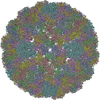
|
| 2 |
|
| 3 | x 5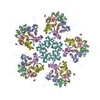
|
| 4 | x 6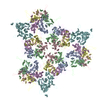
|
| 5 | 
|
| Symmetry | Point symmetry: (Schoenflies symbol: I (icosahedral)) |
- Components
Components
| #1: Protein | Mass: 59103.199 Da / Num. of mol.: 6 Source method: isolated from a genetically manipulated source Source: (gene. exp.)   Human papillomavirus type 58 / Gene: L1 / Production host: Human papillomavirus type 58 / Gene: L1 / Production host:  Homo sapiens (human) / References: UniProt: P26535 Homo sapiens (human) / References: UniProt: P26535Has protein modification | Y | |
|---|
-Experimental details
-Experiment
| Experiment | Method: ELECTRON MICROSCOPY |
|---|---|
| EM experiment | Aggregation state: PARTICLE / 3D reconstruction method: single particle reconstruction |
- Sample preparation
Sample preparation
| Component | Name: Human papillomavirus type 58 / Type: VIRUS / Entity ID: all / Source: RECOMBINANT |
|---|---|
| Source (natural) | Organism:   Human papillomavirus type 58 Human papillomavirus type 58 |
| Source (recombinant) | Organism:  Homo sapiens (human) Homo sapiens (human) |
| Details of virus | Empty: NO / Enveloped: NO / Isolate: SPECIES / Type: VIRION |
| Buffer solution | pH: 7.4 |
| Specimen | Embedding applied: NO / Shadowing applied: NO / Staining applied: NO / Vitrification applied: YES |
| Vitrification | Cryogen name: ETHANE |
- Electron microscopy imaging
Electron microscopy imaging
| Experimental equipment |  Model: Tecnai F30 / Image courtesy: FEI Company |
|---|---|
| Microscopy | Model: FEI TECNAI F30 |
| Electron gun | Electron source:  FIELD EMISSION GUN / Accelerating voltage: 300 kV / Illumination mode: FLOOD BEAM FIELD EMISSION GUN / Accelerating voltage: 300 kV / Illumination mode: FLOOD BEAM |
| Electron lens | Mode: BRIGHT FIELD |
| Image recording | Electron dose: 30 e/Å2 / Detector mode: INTEGRATING / Film or detector model: FEI FALCON II (4k x 4k) |
- Processing
Processing
| CTF correction | Type: PHASE FLIPPING ONLY |
|---|---|
| Symmetry | Point symmetry: I (icosahedral) |
| 3D reconstruction | Resolution: 4.11 Å / Resolution method: FSC 0.143 CUT-OFF / Num. of particles: 13458 / Symmetry type: POINT |
 Movie
Movie Controller
Controller













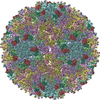
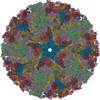
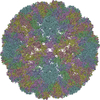
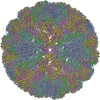
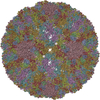
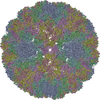
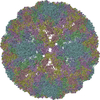
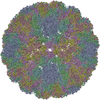
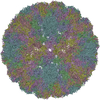

 PDBj
PDBj


